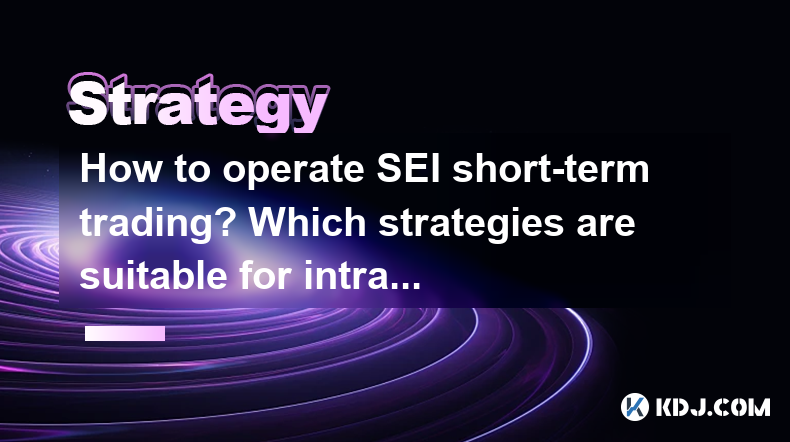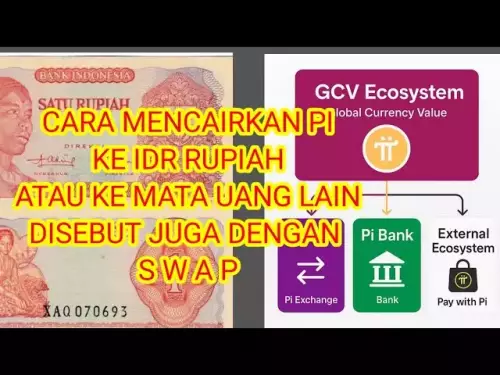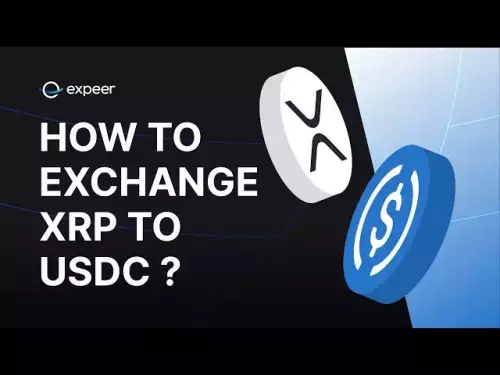-
 bitcoin
bitcoin $112715.707551 USD
-1.71% -
 ethereum
ethereum $4101.475385 USD
-3.01% -
 tether
tether $1.000644 USD
-0.02% -
 bnb
bnb $1207.619465 USD
-6.77% -
 xrp
xrp $2.501451 USD
-3.98% -
 solana
solana $202.947124 USD
-3.32% -
 usd-coin
usd-coin $1.000295 USD
0.04% -
 dogecoin
dogecoin $0.203884 USD
-4.47% -
 tron
tron $0.317154 USD
-1.72% -
 cardano
cardano $0.695009 USD
-4.43% -
 hyperliquid
hyperliquid $38.853961 USD
-8.23% -
 chainlink
chainlink $18.988674 USD
-4.64% -
 ethena-usde
ethena-usde $1.000233 USD
-0.03% -
 stellar
stellar $0.337050 USD
-3.63% -
 bitcoin-cash
bitcoin-cash $536.861728 USD
-1.28%
How to operate SEI short-term trading? Which strategies are suitable for intraday trading?
For SEI short-term trading, use scalping, momentum, and range strategies, set tight stop-losses, and monitor market trends closely to capitalize on intraday price movements.
May 01, 2025 at 03:21 pm

Short-term trading in the cryptocurrency market, particularly with assets like SEI, requires a keen understanding of market dynamics and a robust trading strategy. This article will delve into the specifics of operating SEI short-term trading and highlight strategies that are suitable for intraday trading.
Understanding SEI and Short-Term Trading
SEI, a cryptocurrency known for its volatility, presents numerous opportunities for short-term traders. Short-term trading involves buying and selling assets within a short period, often within the same day, to capitalize on small price movements. The goal is to generate profits from these rapid trades rather than holding assets for long-term gains.
Preparing for SEI Short-Term Trading
Before diving into SEI short-term trading, it's crucial to prepare adequately. Here are the steps to get started:
- Choose a Reliable Exchange: Select a cryptocurrency exchange that supports SEI trading and offers low fees and a user-friendly interface. Popular choices include Binance, Coinbase, and Kraken.
- Set Up a Trading Account: Register on the chosen exchange, complete the KYC (Know Your Customer) process, and fund your account with fiat or other cryptocurrencies.
- Use a Trading Platform or App: Ensure you have access to a reliable trading platform or mobile app that allows real-time monitoring of SEI prices and order execution.
- Learn the Basics: Understand key trading concepts such as order types (market, limit, stop-loss), chart patterns, and technical indicators.
Strategies for SEI Intraday Trading
Intraday trading strategies are essential for navigating the volatile SEI market. Here are some effective strategies:
Scalping
Scalping involves making numerous trades throughout the day to profit from small price changes. This strategy requires a high level of focus and quick decision-making.
- Identify Short-Term Trends: Use technical indicators like moving averages and the Relative Strength Index (RSI) to identify short-term trends.
- Set Tight Stop-Loss Orders: To minimize losses, set stop-loss orders close to your entry price.
- Execute Trades Quickly: Use market orders to enter and exit positions swiftly, capitalizing on small price movements.
Momentum Trading
Momentum trading focuses on assets that are moving significantly in one direction on high volume. This strategy aims to ride the momentum until it shows signs of reversal.
- Monitor Volume and Price: Look for SEI to show significant volume spikes and clear price movements.
- Enter on Breakouts: Enter a trade when SEI breaks out of a resistance level on high volume.
- Use Technical Indicators: Utilize indicators like the Moving Average Convergence Divergence (MACD) to confirm momentum.
Range Trading
Range trading is effective when SEI prices move within a defined range. Traders buy at the lower end of the range and sell at the higher end.
- Identify Support and Resistance: Use historical price data to identify clear support and resistance levels.
- Set Entry and Exit Points: Place buy orders near support levels and sell orders near resistance levels.
- Monitor for Breakouts: Be prepared to exit trades if SEI breaks out of the established range.
Executing SEI Short-Term Trades
To execute SEI short-term trades effectively, follow these detailed steps:
- Analyze the Market: Before placing any trades, analyze the current market conditions using technical and fundamental analysis.
- Set Your Trading Plan: Define your entry and exit points, as well as your risk management strategy, including stop-loss and take-profit levels.
- Place Your Orders: Use the trading platform to place your orders according to your trading plan. Ensure you understand the difference between market and limit orders.
- Market Orders: Execute immediately at the current market price.
- Limit Orders: Execute only at a specified price or better.
- Monitor Your Trades: Keep a close eye on your open positions and be ready to adjust your stop-loss or take-profit levels as the market moves.
- Review and Adjust: After closing your trades, review your performance and adjust your strategy as needed based on your results.
Risk Management in SEI Short-Term Trading
Effective risk management is crucial for success in SEI short-term trading. Here are some key practices:
- Use Stop-Loss Orders: Always set stop-loss orders to limit potential losses on each trade.
- Diversify Your Trades: Avoid putting all your capital into a single trade. Spread your risk across multiple trades.
- Manage Your Position Sizes: Keep your position sizes small to minimize the impact of any single loss on your overall portfolio.
- Stay Informed: Continuously monitor market news and events that could impact SEI prices.
Tools and Resources for SEI Short-Term Trading
To enhance your SEI short-term trading, consider using the following tools and resources:
- TradingView: A powerful charting platform that offers a wide range of technical indicators and drawing tools.
- CoinMarketCap: A reliable source for real-time cryptocurrency prices, market caps, and trading volumes.
- Crypto Trading Bots: Automated trading bots can help execute trades based on predefined criteria, reducing the need for constant manual monitoring.
- Educational Resources: Websites like Investopedia and CryptoQuant provide valuable insights and tutorials on cryptocurrency trading.
Frequently Asked Questions
Q: How much capital do I need to start SEI short-term trading?A: The amount of capital required can vary based on your trading strategy and risk tolerance. As a general rule, start with an amount you can afford to lose, and consider beginning with a smaller amount to gain experience before scaling up.
Q: Can I use leverage in SEI short-term trading?A: Yes, many exchanges offer leverage for cryptocurrency trading, including SEI. However, leverage increases both potential profits and losses, so use it cautiously and ensure you understand the risks involved.
Q: How do I choose the right time frame for SEI intraday trading?A: The choice of time frame depends on your trading strategy and personal preference. For intraday trading, common time frames include 1-minute, 5-minute, and 15-minute charts. Experiment with different time frames to find what works best for you.
Q: What are the tax implications of SEI short-term trading?A: Short-term trading profits are typically subject to capital gains tax, which varies by jurisdiction. It's essential to keep detailed records of your trades and consult with a tax professional to understand your specific tax obligations.
Disclaimer:info@kdj.com
The information provided is not trading advice. kdj.com does not assume any responsibility for any investments made based on the information provided in this article. Cryptocurrencies are highly volatile and it is highly recommended that you invest with caution after thorough research!
If you believe that the content used on this website infringes your copyright, please contact us immediately (info@kdj.com) and we will delete it promptly.
- Zero Knowledge Proof, Whitelist, Blockchain 2025: The Dawn of Private, Scalable Infrastructure
- 2025-10-16 01:20:01
- Altcoins, Whales, and Tariff Threats: Navigating the Crypto Seas
- 2025-10-16 01:20:01
- ChatGPT's Crystal Ball: HBAR Price Prediction and the Rise of Snorter in 2025
- 2025-10-16 01:20:01
- ZEROBASE Listing and Airdrop: A New Era for ZK Tech?
- 2025-10-16 00:25:13
- Digital Euro, Gold Standard, and Active Reserves: A New York Minute on the Future of Money
- 2025-10-16 00:25:13
- TCG OTS Pack Spoilers: What's Hot and What's Not?
- 2025-10-16 00:33:47
Related knowledge

Practical parameter settings for a Bitcoin multi-timeframe moving average system
Sep 18,2025 at 10:54pm
Optimizing Timeframe Combinations for Bitcoin Trading1. Selecting appropriate timeframes is crucial when building a multi-timeframe moving average sys...

How can I filter out false breakouts in Dogecoin high-frequency trading?
Sep 22,2025 at 01:00am
Understanding False Breakouts in Dogecoin Trading1. A false breakout occurs when Dogecoin's price appears to move beyond a defined support or resistan...

Techniques for identifying tops and bottoms in the Bitcoin on-chain NVT model
Sep 20,2025 at 07:54pm
Understanding the NVT Model in Bitcoin Analysis1. The Network Value to Transactions (NVT) ratio is often described as the 'P/E ratio' of the cryptocur...

What does the surge in open interest in Bitcoincoin futures mean?
Sep 20,2025 at 11:18pm
Understanding the Surge in Dogecoin Futures Open Interest1. A surge in open interest within Dogecoin futures indicates a growing number of active cont...

How can I use the Ethereum USDT premium to gauge market sentiment?
Sep 18,2025 at 11:55pm
Understanding the Ethereum USDT Premium1. The Ethereum USDT premium refers to the price difference between USDT (Tether) traded on Ethereum-based plat...

What should I do if Ethereum staking yields decline?
Sep 20,2025 at 06:18am
Understanding the Causes Behind Declining Ethereum Staking Yields1. The Ethereum network transitioned to a proof-of-stake consensus mechanism with the...

Practical parameter settings for a Bitcoin multi-timeframe moving average system
Sep 18,2025 at 10:54pm
Optimizing Timeframe Combinations for Bitcoin Trading1. Selecting appropriate timeframes is crucial when building a multi-timeframe moving average sys...

How can I filter out false breakouts in Dogecoin high-frequency trading?
Sep 22,2025 at 01:00am
Understanding False Breakouts in Dogecoin Trading1. A false breakout occurs when Dogecoin's price appears to move beyond a defined support or resistan...

Techniques for identifying tops and bottoms in the Bitcoin on-chain NVT model
Sep 20,2025 at 07:54pm
Understanding the NVT Model in Bitcoin Analysis1. The Network Value to Transactions (NVT) ratio is often described as the 'P/E ratio' of the cryptocur...

What does the surge in open interest in Bitcoincoin futures mean?
Sep 20,2025 at 11:18pm
Understanding the Surge in Dogecoin Futures Open Interest1. A surge in open interest within Dogecoin futures indicates a growing number of active cont...

How can I use the Ethereum USDT premium to gauge market sentiment?
Sep 18,2025 at 11:55pm
Understanding the Ethereum USDT Premium1. The Ethereum USDT premium refers to the price difference between USDT (Tether) traded on Ethereum-based plat...

What should I do if Ethereum staking yields decline?
Sep 20,2025 at 06:18am
Understanding the Causes Behind Declining Ethereum Staking Yields1. The Ethereum network transitioned to a proof-of-stake consensus mechanism with the...
See all articles










































































